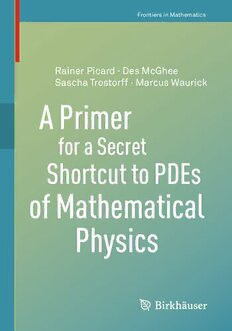Table Of ContentFrontiers in Mathematics
Rainer Picard · Des McGhee
Sascha Trostorff · Marcus Waurick
A Primer
for a Secret
Shortcut to PDEs
of Mathematical
Physics
Frontiers in Mathematics
AdvisoryBoard
LeonidBunimovich(GeorgiaInstituteofTechnology,Atlanta)
WilliamY.C.Chen(NankaiUniversity,Tianjin)
BenoîtPerthame(SorbonneUniversité,Paris)
LaurentSaloff-Coste(CornellUniversity,Ithaca)
IgorShparlinski(TheUniversityofNewSouthWales,Sydney)
WolfgangSprößig(TUBergakademieFreiberg)
CédricVillani(InstitutHenriPoincaré,Paris)
Moreinformationaboutthisseriesathttp://www.springer.com/series/5388
Rainer Picard • Des McGhee (cid:129) Sascha Trostorff (cid:129)
Marcus Waurick
A Primer for a Secret
Shortcut to PDEs
of Mathematical Physics
RainerPicard DesMcGhee
Institutfu¨rAnalysis DepartmentofMathematicsandStatistics
TUDresden UniversityofStrathclyde
Dresden,Germany Glasgow,UK
SaschaTrostorff MarcusWaurick
MathematischesSeminar DepartmentofMathematicsandStatistics
Christian-Albrechts-Universita¨tzuKiel UniversityofStrathclyde
Kiel,Germany Glasgow,UK
ISSN1660-8046 ISSN1660-8054 (electronic)
FrontiersinMathematics
ISBN978-3-030-47332-7 ISBN978-3-030-47333-4 (eBook)
https://doi.org/10.1007/978-3-030-47333-4
MathematicsSubjectClassification:35F,35-01
©SpringerNatureSwitzerlandAG2020
This work is subject to copyright. All rights are reserved by the Publisher, whether the whole or part of
the material is concerned, specifically the rights of translation, reprinting, reuse of illustrations, recitation,
broadcasting,reproductiononmicrofilmsorinanyotherphysicalway,andtransmissionorinformationstorage
andretrieval,electronicadaptation,computersoftware,orbysimilarordissimilarmethodologynowknownor
hereafterdeveloped.
Theuseofgeneraldescriptivenames,registerednames,trademarks,servicemarks,etc.inthispublicationdoes
notimply,evenintheabsenceofaspecificstatement,thatsuchnamesareexemptfromtherelevantprotective
lawsandregulationsandthereforefreeforgeneraluse.
Thepublisher,theauthors,andtheeditorsaresafetoassumethattheadviceandinformationinthisbookare
believedtobetrueandaccurateatthedateofpublication. Neitherthepublishernortheauthorsortheeditors
giveawarranty,expressedorimplied,withrespecttothematerialcontainedhereinorforanyerrorsoromissions
thatmayhavebeenmade.Thepublisherremainsneutralwithregardtojurisdictionalclaimsinpublishedmaps
andinstitutionalaffiliations.
ThisbookispublishedundertheimprintBirkhäuser,www.birkhauser-science.com,bytheregisteredcompany
SpringerNatureSwitzerlandAG.
Theregisteredcompanyaddressis:Gewerbestrasse11,6330Cham,Switzerland
Introduction
A typicalentry pointinto the field of (linear)partialdifferentialequationsis to consider
generalpolynomialsP (∂)in∂ :=(∂ ,...,∂ )with(complexorreal)matrixcoefficients.
0 n
Here∂ denotesthepartialderivativewithrespecttothevariableinthepositionlabelled
k
with1 k ∈ {0,...,n}, n ∈ N. Evenif we discusssolutionsonlyin thewholeEuclidean
spaceRn+1 thesolutiontheoryforanequationoftheform
P (∂)u=f
involving a general partial differential operator P (∂) is quite involved and one quickly
restrictsattentiontoveryspecificpolynomials.Indeed,theequationsrelevanttoapplica-
tionsarenotthatvaried.Onecommonlyinvestigatesthreesubclasses,looselylabelledas
elliptic,parabolic,andhyperbolic,topresentspecificsolutionmethodsforeachofthem.
However,whenviewedfromtherightperspectivethereisasinglesubclasscontaining
these three types (and manymore), which can be characterizedconvenientlyand solved
with one and the same method. To explain the correspondingrigorousframeworkis the
objectiveofthistext.
Thetheorywewillpresentinthisbookisrootedin[57],withsomefirstgeneralizations
tobefoundin[55,59].Weshallreferalsoto[63,79,83,87,88]forgeneralizationstowards
nonlinear or non-autonomous setups. The interested reader will find a more detailed
surveyin[68,75].Inthepresentbook,however,weshallpresentthecoreyetsurprisingly
elementarysolutiontheoryforwhatwewillcallevolutionaryequations.
Thestructureofthisclassofpartialdifferentialexpressionscanbeformallydescribed
by two matrices2 M ,M ∈ R(N+1)×(N+1), N ∈ N. The partial differential operator
0 1
1Notethatweusuallyprefertostartournumberingwith0.Inparticular,Ndenotesthesetofnon-
negativeintegers.
2Indeed,keepinginmindthatacomplexnumberx+iy canbeunderstoodasa(2×2)-matrixof
theform
(cid:2) (cid:3)
x −y
,
y x
wherex,y ∈R,wemayactuallyassumethatM0andM1haveonlyrealentries.
v
vi Introduction
P (∂)willthenbeassumedtobeoftheform
(cid:4) (cid:6)
P (∂)=∂ M +M +A (cid:5)∂ , (1)
0 0 1
(cid:4) (cid:6)
where A (cid:5)∂ denotesa polynomialin(cid:5)∂ := (∂ ,...,∂ ), that is, borrowingjargonfrom
1 n
applied fields, only in the “spatial” variables, if we consider ∂ to be the derivative
0
with respect to “time”. In this terminology,if we focus on “relevant” partial differential
equations, we may focuson first-order-in-timesystems. Moreover,in standard cases we
have structural features of P (∂) which narrow down the class of differential operators
evenfurther.Weassume3
(cid:4) (cid:6) (cid:4) (cid:6)
A∗ −(cid:5)∂ =−A (cid:5)∂
and
(cid:4) (cid:6)
M =M∗and ReM := 1 M +M∗ ≥c >0. (2)
0 0 1 2 1 1 0
Inapplications,thelatterpositivedefinitenessconstraintisrarelysatisfied.However,after
asimpleformaltransformation4 weget
(cid:4) (cid:6) (cid:4) (cid:4) (cid:6)(cid:6)
∂ M +M(cid:7) +A (cid:5)∂ =exp(−(cid:3)m ) ∂ M +M +A (cid:5)∂ exp((cid:3)m )
0 0 1 0 0 0 1 0
(cid:4) (cid:6) (cid:4) (cid:6)
3Withthis,A (cid:5)∂ becom(cid:8)esskew(cid:9)-selfadj(cid:4)oin(cid:6)tinL2(cid:10)Rn and—bycanonic(cid:4)al e(cid:6)xtensionto(cid:4)the(cid:6)time-
d(cid:10)ependent c(cid:4)ase—(cid:6)in L2 R1+n . If A (cid:5)∂ = α∈NnAα(cid:5)∂α, then A (cid:5)∂ ∗ = A∗ −(cid:5)∂ :=
α∈NnA∗α −(cid:5)∂ α and this constraint means that the matrix coeffic(cid:10)ients Aα, α = (α1,...,αn),
are selfadjoint or skew-selfadjo(cid:4)int(cid:6)depending on the order |α| := nk=1αk being even or odd,
(cid:5)
respectively.NotethatsinceA ∂ isapolynomial,onlyfinitelymanyofthecoefficientsarenon-
vanishing.Inmostcases,themaximalorderisactuallyalsojust1. (cid:8) (cid:9)
4This transformation shifts the rigorous functional analytical discussion from L2 Rn+1 to the
(cid:8) (cid:4) (cid:6)(cid:9)
moreappropriatesettingintheHilbertspaceH(cid:3),0 R;L2 Rn ,whichisdefinedsuchthat
(cid:8) (cid:4) (cid:6)(cid:9) (cid:8) (cid:4) (cid:6)(cid:9) (cid:8) (cid:9)
exp(−(cid:3)m0):H(cid:3),0 R;L2 Rn →L2 R;L2 Rn =L2 R1+n
ϕ(cid:6)→exp(−(cid:3)m0)ϕ
becomes a unitary mapping. Here the multiplication operator exp(−(cid:3)m0) is defined via
(exp(−(cid:3)m0)ϕ)(t):=exp(−(cid:3)t)ϕ(t),t ∈R.Wewillbemorepreciseanddetailedlater.
Introduction vii
where
M(cid:7) :=M −(cid:3)M .
1 1 0
Now,theconstraints(2)translateto
M =M∗and(cid:3)M +ReM ≥c >0 (3)
0 0 0 1 0
and the latter strict positive definitenessconstraintneedsto holdonly for all sufficiently
large(cid:3) ∈ ]0,∞[.Asweshallseelater,theparticularroleoftimeisencodedinthisbias
forpositivevaluesofparameter(cid:3).
Toimproveontherangeofapplicability,wewillgeneralizetheaboveproblemclassby
allowingM andM tobeHilbertspaceoperatorsandAtobeageneralskew-selfadjoint
0 1
operatorsothatoperatorsofthe“space-time”form
∂ M +M +A (4)
0 0 1
can be treated. In the proper setting, ∂0 will be seen to be a continuously(cid:8)inve(cid:9)rtible
operator, which, among other things, allows us to consider the operator M ∂−1 :=
0
M0 +∂0−1M1, which in a(cid:8)pplica(cid:9)tionoccurswhen describingso-called material laws. We
thereforeshallrefertoM ∂−1 aswellastoM andM asmateriallawoperators.This
0 0 1
settingessentiallyyieldsanewnormalformforpartialdifferentialequationsoccurringin
numerousapplications.
In the following, we shall rigorously develop the solution theory of these abstract
equations,which—dueto theirimpliedcausalityproperties—wereferto asevolutionary
equations.Weusethetermevolutionaryinasomewhatsubtleattempttodistinguishthem
from the classical concept of evolution equations, which are explicit first-order-in-time
equations.
Althoughthisclasscanbereadilygeneralizedtoincludemorecomplicatedcases,such
∗
asmerelyassumingthatthenumericalrangesofA,A areintheclo(cid:8)sedc(cid:9)omplexrighthalf-
planeorallowingformorecomplicatedmateriallawoperatorsM ∂−1 withthepositive
0 (cid:8) (cid:9)
definitenessconstraintthatforsomec ∈]0,∞[thenumericalrangeof∂ M ∂−1 −c
0 0 0 0
isintheclosedcomplexrighthalf-plane(forallsufficientlylarge(cid:3) ∈ ]0,∞[)(seeagain
e.g.[59,75]),weshallfocushereonthemoreeasilyaccessiblepuredifferentialcase.
Eventually, we aim at a solution theory with easy to check assumptions that lead to
well-posednessofaratherlargeclassofpartialdifferentialequations.Indeed,wewillsee
thatwell-posednessofanevolutionaryequationboilsdowntoprovinganumericalrange
constraintforcertainboundedoperatorsonly.
In Chap.1, we developthe functionalanalyticalsetting and the basic solutiontheory.
Chapter 2 illustrates the theory for a number of model problems from mathematical
viii Introduction
physics. This concludes the book’s core material. Chapter 3 addresses some of the
issuesthatmayarisewhencomparingourapproachwithsomealternative,possiblymore
mainstreamideasfordealingwithproblemsofthesametype.Twoappendicescomplement
thebook’smaterialbyprovidingadditionalideasforexpandingontheapplicabilityofthe
approach,AppendixA,andcollectingsomebackgroundmaterialfromfunctionalanalysis
asastudyresource,AppendixB.
Contents
1 TheSolutionTheoryforaBasicClassofEvolutionaryEquations............ 1
1.1 TheTimeDerivative........................................................... 1
1.2 AHilbertSpacePerspectiveonOrdinaryDifferentialEquations........... 9
1.3 EvolutionaryEquations ....................................................... 14
2 SomeApplicationstoModelsfromPhysicsandEngineering.................. 31
2.1 AcousticEquationsandRelatedProblems................................... 32
2.2 AReductionMechanismandtheRelativisticSchrödingerEquation....... 38
2.3 LinearElasticity............................................................... 46
2.4 TheGuyer–KrumhanslModelofThermodynamics......................... 60
2.5 TheEquationsofElectrodynamics........................................... 68
2.6 CoupledPhysicalPhenomena ................................................ 88
3 ButWhatAbouttheMainStream?............................................... 103
3.1 WhereistheLaplacian?....................................................... 103
3.2 WhyNotUseSemi-Groups?.................................................. 109
3.3 WhatAboutOtherTypesofEquations?...................................... 114
3.4 WhatAboutOtherBoundaryConditions?................................... 118
3.5 WhyAllThisFunctionalAnalysis?.......................................... 121
A TwoSupplementsfortheToolbox................................................. 123
A.1 MothersandTheirDescendants.............................................. 123
A.2 Abstractgrad-div-Systems ................................................... 126
B RequisitesfromFunctionalAnalysis.............................................. 129
B.1 FundamentalsofHilbertSpaceTheory ...................................... 129
B.2 TheProjectionTheorem ...................................................... 137
B.3 TheRieszRepresentationTheorem .......................................... 141
B.4 LinearOperatorsandTheirAdjoints......................................... 144
ix

